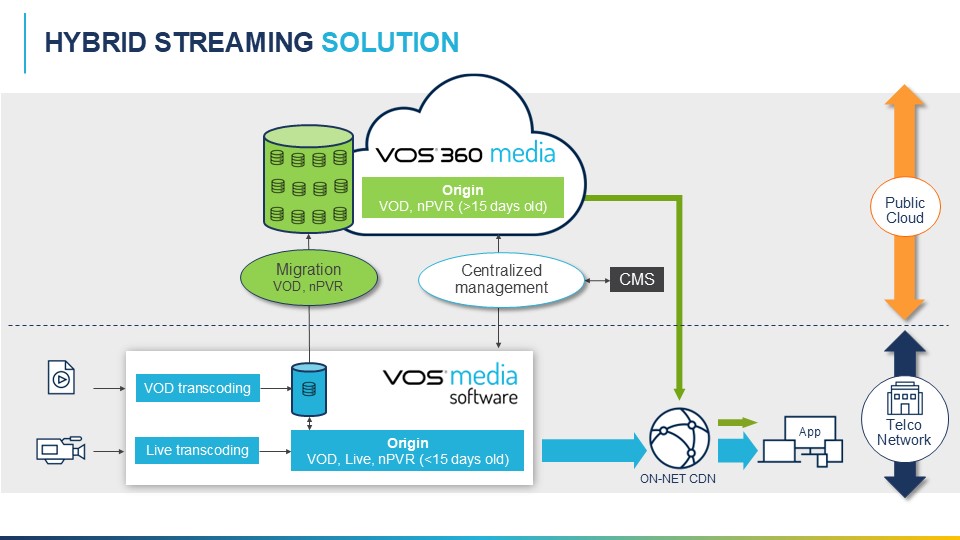Sponsored: Smart Streaming: How Hybrid Architectures Are Powering Agile Media Operations
A hybrid streaming model that integrates on-premises infrastructure and the cloud gives service providers an operational advantage

In today’s video streaming landscape, agility and cost efficiency are critical for success. As consumer expectations grow for live events, personalized content and immersive ad formats, service providers face increasing pressure to optimize every aspect of their operations.
At the same time, the convergence of traditional broadcast and streaming workflows is reshaping video infrastructure, driving the need for unified, flexible solutions. To remain competitive, service providers must go beyond delivering exceptional streaming experiences; they must also reduce complexity and costs.
Traditional “one-size-fits-all” streaming solutions are no longer sufficient to meet the requirements of service providers. A hybrid streaming model — integrating on-premises infrastructure and the cloud — gives service providers an operational advantage, providing the flexibility and resilience needed to meet current demands while ensuring operations are future-ready.
The Operational Pitfalls of One-Size-Fits-All Streaming
As demand for video streaming intensifies, on-premises infrastructures are struggling to accommodate the scale, agility and personalization required to deliver high-quality viewer experiences. To meet peak traffic for live events, operators often resort to overprovisioning infrastructure. Yet, in some cases, these extra resources fall short. When the infrastructure is under provisioned, video streaming quality can suffer during spikes in viewer demand, especially for major sports events.
While cloud-only approaches offer elasticity and scalability, they can also present challenges. Using the public cloud for all video workflows is cost prohibitive.
The reality is that a cloud- or on-premises-only architecture cannot meet the diverse demands of video streaming. Service providers need hybrid infrastructures that balance cost, performance and flexibility across cloud and on-premises environments. By blending the cloud with on-premises infrastructure, service providers can dynamically shift workloads to meet real-time demands, delivering a wide range of experiences from FAST and pop-up channels to premium live events. Ultimately, hybrid architectures enable service providers to support evolving viewer expectations without sacrificing operational agility or budget.
The professional video industry's #1 source for news, trends and product and tech information. Sign up below.
Harmonic’s VOS®360 SaaS Solutions: Driving Hybrid Streaming Innovation
Harmonic is at the forefront of hybrid streaming innovation with its VOS360 Media SaaS and VOS Media Software.
A key use case for Harmonic’s hybrid streaming solution is the management of VOD and network PVR storage. Viewers tend to enjoy watching newly released or freshly recorded content, while older assets take up valuable storage space in service providers’ libraries. Harmonic’s hybrid streaming solution addresses this issue by enabling providers to store large-scale archival content economically on public cloud, while keeping high-demand, fresh content on-premises. This approach not only reduces the total cost of ownership but also ensures an optimized viewer experience by enabling instant access to the most relevant content, without sacrificing the accessibility of archival libraries (see Figure 1).

A crucial advantage of the hybrid streaming solution is its centralized management system that reduces the complexity of operating across both on-premises and cloud environments. Operators can manage, monitor and configure the entire workflow from a single user interface. Migrating content from on-premises to the cloud is fully automated, based on rules such as content freshness. It is also transparent to the content management system (CMS), ensuring seamless operations. This significantly reduces complexity, streamlines resource allocation and lowers costs for service providers.
Another unique benefit of the hybrid streaming solution is EyeQ™ content-aware encoding for live and file-based transcoding. This advanced encoding technology significantly reduces bandwidth requirements and minimizes cloud and CDN storage costs. With EyeQ content-aware encoding, service providers can save approximately $1,100 each day, assuming 300,000 viewers are watching video content two hours daily, making it a powerful tool for maintaining high video quality while optimizing resource usage in hybrid streaming environments.
In addition, the hybrid streaming solution enhances VOD asset transcoding, enabling service providers to balance transcoding tasks between on-premises and cloud resources. Service providers can handle routine workloads, such as adding 10 to 20 new movies to a streaming platform on a weekly basis, on-premises. For peak demands like onboarding a full content library from a major partner (e.g., Disney+), service providers can transcode thousands of assets in the cloud to avoid costly overprovisioning. This hybrid strategy ensures high scalability and cost efficiency.
Furthermore, Harmonic’s hybrid streaming solution improves disaster recovery and operational reliability. By leveraging the built-in redundancy, geographic distribution and failover capabilities of the cloud, service providers can protect their on-premises infrastructure and maintain service uptime during unexpected disruptions.
Future-Proof Streaming Starts with a Hybrid Foundation
Hybrid streaming empowers service providers to boost efficiency, reduce costs and scale their video streaming services across cloud and on-premises infrastructure. By partnering with Harmonic, service providers can lead the hybrid streaming transformation with innovative SaaS and software-based solutions that simplify operations via a centralized management system, enhance viewer experiences and deliver the flexibility needed to thrive in an evolving media landscape.
About Harmonic

Harmonic, the worldwide leader in video delivery, enables media companies and service providers to deliver next-generation streaming and broadcast services to consumers globally. Powering millions of simultaneous streams, thousands of live channels, and countless VOD requests, Harmonic's innovative cloud and software-based offerings simplify all stages of media processing and delivery for exceptional-quality video experiences. To ensure the highest service availability, Harmonic’s worldwide DevOps team provides 24/7 monitoring of the cloud platform. Whether powering live sports, ad-supported TV, TV everywhere or cloud broadcast delivery, Harmonic enables operators to meet the demand for scalable video services. More information is available at www.harmonicinc.com.

As vice president of video solutions at Harmonic, Eric Gallier leads the team responsible for establishing and promoting the company's cloud-based and on-prem video solutions. With over two decades of experience in the media technology industry, Eric plays a pivotal role in shaping Harmonic’s video solutions strategy, driving thought leadership and innovation in video processing and streaming infrastructures. Previously, Eric led marketing initiatives at Thomson Video Networks (TVN) before being acquired by Harmonic. Eric received a software engineering degree at the Ecole Supérieure D’Electricité (ESE) based in Paris.
